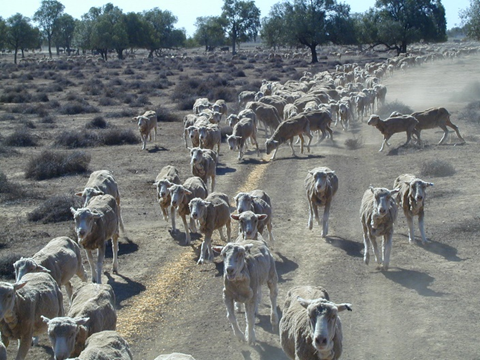Transporting compromised sheep

Compromised sheep include those which are nutritionally deficient and in weak (e.g. drought affected animals) or have been compromised from extreme events such as bushfires and floods.
-
Develop and implement appropriate pre-journey management and journey plans with the transport operator. Consider the condition of animals, breed, location, weather, distance and geography of journey. These will all contribute to the animal’s capacity to travel.
-
Consider if animals are in distress or if they are they moving freely and comfortably.
-
Animals must be fit to load – 'If in doubt, leave them out’. If the animal is not fit to load, you must:
-
Treat the animal and reassess, then once recovered and fit to load, the animal can be transported, or
-
Consult a vet and then transport under veterinary certification and provide bedding when transporting these animals. In this case, it is best to pen these animals (as much as practicable) in the bottom deck, back pen of the truck, to enable easier access if there are complications or difficulties, or.
-
Euthanise the animal on farm
-
-
Body Condition Score 1 (BCS1) sheep:
- BCS1 sheep must be kept on feed until ‘pick-up’. Feed should be good quality hay and a rumen supplement and feeding should commence at least three days before transport. Discuss with your transporter taking them off water 24–36 hours prior to trucking, noting consideration of journey duration and time of year are critical. This class of animal are vulnerable to cold weather.
- BCS1 sheep should be placed on good quality dry hay and a rumen supplement upon arrival. Feed them first and then slowly introduce clean water for at least three days after arrival.
- BCS1 sheep, if prepared correctly can travel more than eight hours and trucks should be checked at 30–60 minutes, then at two to three hour intervals and alongside mandatory driver rest stops to ensure sheep are standing.
- Load sheep by body condition status i.e. draft BCS1 together and BCS2 together.
-
Pregnant ewes:
-
Ewes that are three months pregnant or more must be transported with veterinary recommendations, remembering a sheep pregnancy is around five months. Preparation is key.
-
Often sheep may not look obviously pregnant until six weeks before lambing.
-
-
Sheep of any type that run in off lush green feed, straight out of the paddock immediately before loading:
-
These sheep pose increased animal welfare, food safety and environmental risks.
-
The risk of slipping, falling and fleece contamination during abattoir processing is higher when there’s more liquid effluent in the truck’s crate.
-
-
Saleyard transactions that have had animals experience extended periods with access to only water and not to feed:
-
These sheep are at are higher risk.
-
-
Poorly handled sheep:
-
Sheep that have run out of the paddock with excessive poor handling, just prior to the truck arriving and loading are usually in a hot and stressed condition and subsequently often do not travel well.
-
-
Cull ewes:
-
Some are more resilient than others, however higher risk cull sheep are often in poor body condition and have a lack adequate energy levels to withstand the increased stress of transport.
-
-
Newly weaned animals:
-
Do not wean onto the back of a truck!
-
Resources:
Preparation considerations for sheep during drought
- Generally, it is recommended (at a minimum) to feed all classes of sheep good quality, dry hay for at least two days with a rumen supplement prior to loading. Ensure they also have access to clean drinking water, however it is recommended to take them off water 24–36 hours, noting time off water prior to transport will need to take into consideration journey duration and time of year. Drought sheep should be monitored every hour during their journey.
- There is a fine-line between truck pen densities that are too loose and too tight. Animals should be firm enough to support each other as the vehicle moves around but not so loose that they are at higher risk of falling over.
- Drought animals often have compromised rumens from lack of feed intake, therefore careful preparation and recovery are critical. Upon arrival, ensure they are put in a holding yard or paddock to recover on good quality feed and a rumen supplement for up to 72 hours.
Fit to load checklistBefore livestock are loaded, ensure you complete this checklist. Remember, it’s your responsibility to ensure animals are fit to load and fit for the intended journey ahead of loading. The animal:
Note: If the animal was grazed on lush green pasture, ensure it was removed from the paddock well in advance of loading and provided with access to adequate roughage (where possible). Make sure the animals are prepared in the best way possible, noting water curfew is very important when transporting goats. Ensure paperwork is completed and facilities are safe, operational and ready for when the truck arrives to load your consignment. |


